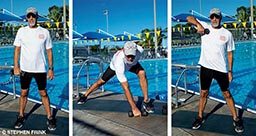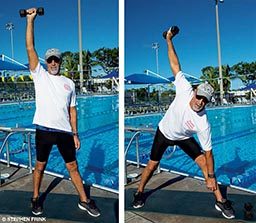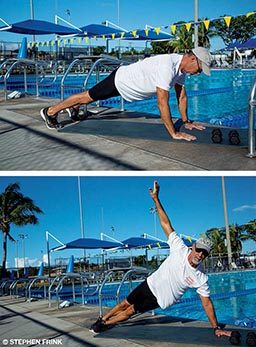Since the late 1800s, exercise has been known to contribute to the well-being of the body and the mind. With a protective effect on the brain, it has been demonstrated to be more effective than antidepressants at relieving depression (and preventing relapse). While the combination of type, intensity and volume of exercise needed for optimal brain function is unknown, we do know the following:
- Increased blood flow to the brain seems to contribute to improved brain function as we age.
- Mental stimulation improves brain function.
- Crossing the body’s midline is regularly integrated in early developmental activity for brain development.
- Staying connected socially correlates with a reduced risk of dementia.
- Promote brain health by exercising often, maintaining an elevated heart rate, doing complex exercises involving movements that cross the midline and exercising with a friend.
The following exercises can benefit both your mind and body. A fit body and sharp mind are important for everyone and are particularly useful for divers. Start with a single set of each exercise, with the goal of progressing to three consecutive sets. Morning is the best time to exercise to keep your brain sharp for the day, but any time is better than not at all.
Side Lunge with Upright Row

Complete 12 repetitions on each side per set.
- Stand with your feet shoulder width apart, and hold a dumbbell down in front of you in one hand.
- Step laterally on the nonweighted side while keeping your feet facing forward. Shift back your hips, and maintain a flat back (never round your back). During the lunge, sit back, leaving the leg on the weighted side straight and bending your knee on the nonweighted side. Place the hand with the weight near the ground in front of the bent knee.
- While returning to the starting position, row by pulling the weight upward, leading with the elbow as you stand. End with the elbow level with the shoulder.
- Lower your arms to return to the starting position.
Tip: Sit back into the lunge so your body weight is in the heel of your bent leg.
Challenges: Go deeper into the lunge, and gradually increase the weight.
Dumbbell Windmill

Complete five repetitions on each side per set.
- While holding a dumbbell in one hand, start with your feet slightly wider than shoulder width apart and your toes pointing slightly toward the nonweighted side.
- Raise the arm with the dumbbell straight up.
- Push your weight and hips back while looking up at the arm that is raised.
- Bend at the waist, sliding your nonweighted arm down the front of your leg while looking at the raised arm.
- Return to the starting position.
Tips:
- Move slowly, and listen to your body.
- Do not force your range of motion (ROM).
- Bend your knee slightly on the side without weight, if necessary.
Challenges:
- Gradually increase your ROM, moving your hand farther down your leg.
- Gradually progress to using heavier weights.
T Plank

Complete 15 repetitions per set.
- Start in the push-up position, with your hands directly under your shoulders.
- Straighten one arm while lifting the other toward the ceiling by twisting your hips and shoulders.
- Hold for 15 seconds.
- Repeat on the opposite side.
Tips:
- You can start in modified push-up position (on knees instead of toes).
- Make sure you contract your abdominals to stabilize your core throughout the exercise.
Challenges:
- Raise your upper leg when in T-position.
- Increase the hold time to 30 seconds.
Squat to Curtsy Squat

Complete 15 repetitions per set.
- Stand with your feet wider than shoulder width apart, and hold a dumbbell in one hand.
- Sit back into a traditional squat, keeping your weight in your heels and your chest up.
- Return to standing position.
- Using the leg that’s on the same side as the dumbbell, step back and across into a curtsy.
- Drop down, keeping your weight balanced on your front heel while maintaining an upright position.
- Return the rear foot to the starting position, keeping the upper body tall.
Tips:
- Start without a weight.
- Start with a less pronounced cross on the curtsy by putting your curtsy foot directly behind your front foot in a more traditional lunge position.
Challenges:
- Gradually progress deeper into the curtsy.
- Gradually progress into a more pronounced curtsy.
Dumbbell Lunge with a Twist

Complete 12 repetitions on each side per set.
- Stand with your feet wider than shoulder width apart, and use both hands to hold a dumbbell out in front of you.
- Step forward into a lunge, and rotate the dumbbell away from the extended leg.
- Keep both knees at right angles while maintaining an upright position.
- Return the dumbbell to center while pushing back and up into the starting position, using a controlled motion.
Tip: Practice with no weight to learn the movement.
Challenges:
- Perform a deeper lunge.
- Increase the repetitions.
Push-Up Knee Cross to Elbow

Complete six repetitions on each side per set. This is a challenging exercise, so adjust the repetitions as needed to ensure proper form.
- Start in the push-up position, with your hands directly under your shoulders.
- Lower your body toward the ground while keeping your elbows close to your rib cage.
- Rotate your hips, and bring the opposite knee to the opposite elbow.
- Return to the starting position while keeping your back flat and abdominals tight.
Tip: Maintain a flat back, keeping the hips in a straight line from the head to toes.
Challenge: Hold the knee-to-elbow position for a static 10 count.
NOTE: To avoid an increased risk of decompression sickness, DAN® recommends that divers avoid strenuous exercise for 24 hours after making a dive. During your annual physical exam or following any changes in your health status, consult your physician to ensure you have medical clearance to dive.
| © Alert Diver — Q4 2018 |